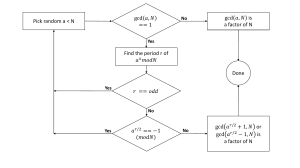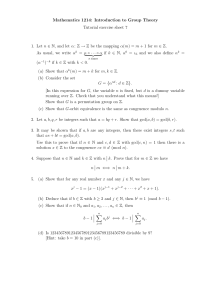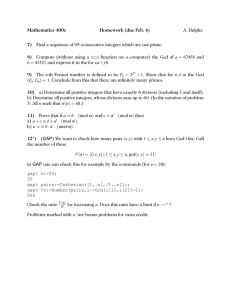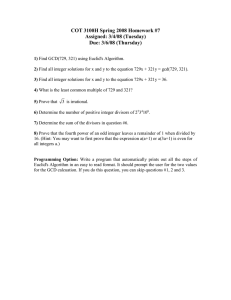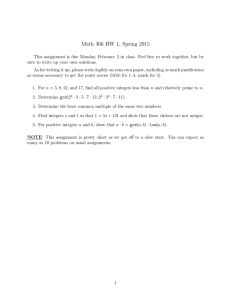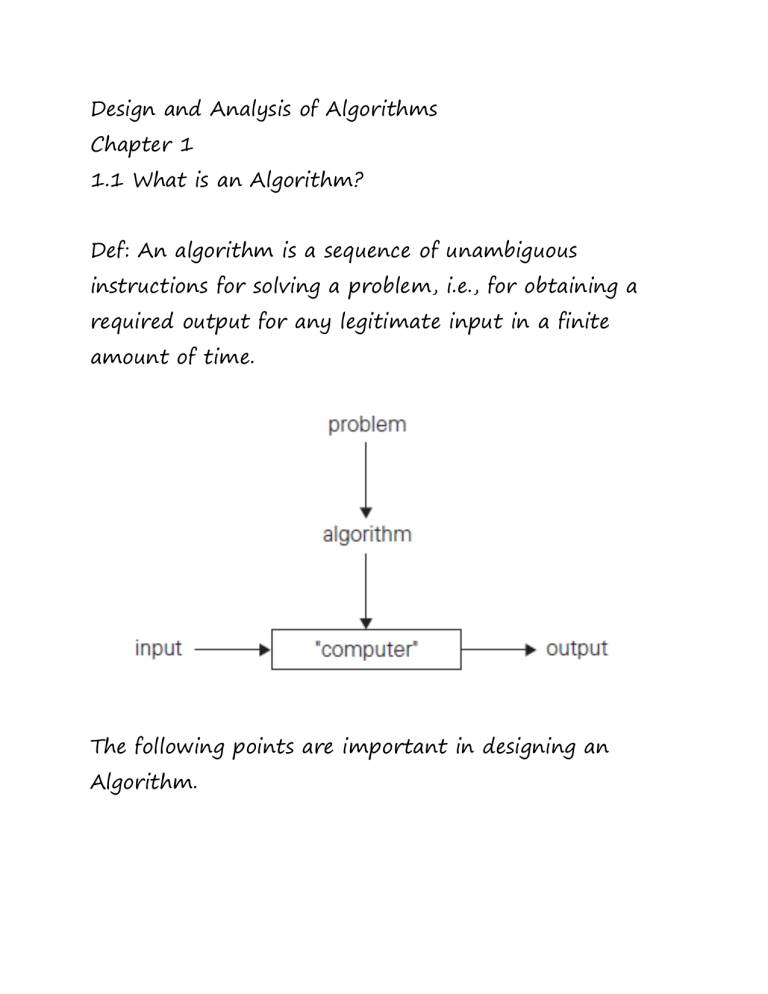
Design and Analysis of Algorithms
Chapter 1
1.1 What is an Algorithm?
Def: An algorithm is a sequence of unambiguous
instructions for solving a problem, i.e., for obtaining a
required output for any legitimate input in a finite
amount of time.
The following points are important in designing an
Algorithm.
1. The unambiguity requirement for each step of the
algorithm cannot be compromised.
2. The range of inputs for which an algorithm works
has to be specified carefully.
3. The same algorithm can be represented in several
different ways.
4. There may exist several algorithms for solving the
same problem.
5. Algorithms for the same problem can be based on
very different ideas and can solve the problem with
dramatically different speeds.
Recall The Greatest Common Divisor Problem
Definition: Let a and b be integers, not both zeros. The
largest integer d such that d|a and d|b is called the
greatest common divisor of a and b, and it is denoted by
gcd(a,b). Where the gcd(a,0)=a (gcd(0,b)=b
Note: The symbol d|a is read as "d divides a." and it
means that d divides a without remainder. i.e a mod d
=0 or a/d=c, where c is an integer.
There are several methods to find the gcd(a,b)
- Euclidian's Algorithm
- By definition
- Sorting out the common divisors
- Prime Factorization
Method 1: The Euclidean Algorithm
Theorem: Let a=bq+r, where a, b, q, and r are integers.
Then gcd(a,b)=gcd(b,r).
Why? (proof)
Let d=gcd(a,b)
Then by def, we have
d|a and d|b
From Number theory we know that: if an integer d
divides two integers a and b then it also divides any
linear combination of a and b.
Therefore, a linear combination of a and b that we have
is (a-bq), therefore,
If d|a and d|b then d|(a-bq)
But, a-bq=r
Therefore, d|r
Now we have d|b and d|r, then d is gcd(b,r), but
d=gcd(a,b)
Then gcd(a,b)=gcd(b,r)
Which means, instead of finding the gcd(a,b), we find
the gcd(b,r) and so on we keep reducing the integers
until we reach r=0. When r=0, gcd(b,r)=b
Ex: find gcd(27,366) by Euclidian's Algorithm.
Solution
366=27(13)+15
27=15(1)+12
15=12(1)+3
12=3(4)+0 →gcd(3,0)=3
Or we can say: the gcd(366,27) is the last non-zero
remainder. That is gcd(366,27)=3
The Algorithm: [Euclidian's]
S1 Input a,b, with a>b
S2 if b=0 then return a as gcd(a,b)
S3 If b≠0 then compute r=a mod b
S4 Set a=b and b=r then go to S2
Method 2: [By Definition]
This method is based on the definition where the
greatest common divisor of a and b is the largest integer
that divides both a and b
Note: Since gcd(a,b) divides both a and b, the gcd(a,b)<a
and gcd(a,b)<b. Let d=gcd(a,b) with a>b. therefore, it is
also possible that gcd(a,b)=b.
First thing we do is to set d=min(a,b). Then we check if d
divides a and b. if it does then d is outcome. If it does
not, then we reduce d by 1 and try again.
Ex: Find gcd(18,60)
60>18 → gcd(60,18)=d → d=min(60,18)=18
Check: if
18|60 no and 18|18 yes →
d=18-1
17|60 no and 17|18 no →
d=17-1
…
d=7-1
6|60 yes and 6|18 yes
Then d=6 is the gcd(60,18)
The algorithm: [by def]
S1 Input a, b with a>b
S2 set d=min{a,b}
S3 if a mod d=0 then go to S4, otherwise go to S5
S4 if b mod d=0 then go to S6, otherwise go to S5
S5 d=d-1 go to S3
S6 return d=gcd(a,b)
Note: There is a way to improve the algorithm by
combining S3 and S4 into one step by using the logical
operation AND
Note: unlike Euclidian's algorithm, this algorithm will fail
if one of the integers is zero. It means the algorithm here
is not specific.
Method 3: Listing The divisors of a and b
This method also depends on the definition. But it
depends more on following the definition literally.
Ex: find gcd(60,18) by listing the divisors
Ans:
60: 1,2,3,4,5,6,10,12,15,20,30,60
18: 1,2,3,6,9,18
The largest common divisor is 6 so d=6 is the
gcd(60,18)
The algorithm: [by listing the divisors]
S1 find the divisors of a and name them as a1, a2, …, an
S2 find the divisors of b and name them as b1, b2, …, bn
S3 Sort out the common divisors that are found in S1
and S2 and name them as d1, d2, …, dk
S4 d=max{d1, d2, …, dk}, d=gcd(a,b)
The problem with this algorithm is in the first two steps.
Finding divisors of an integer usually takes time,
especially if the integer is large. The fastest way to find
all the divisors is by starting with the number itself and
dividing it by itself, then reducing it by 1 and start
again.

